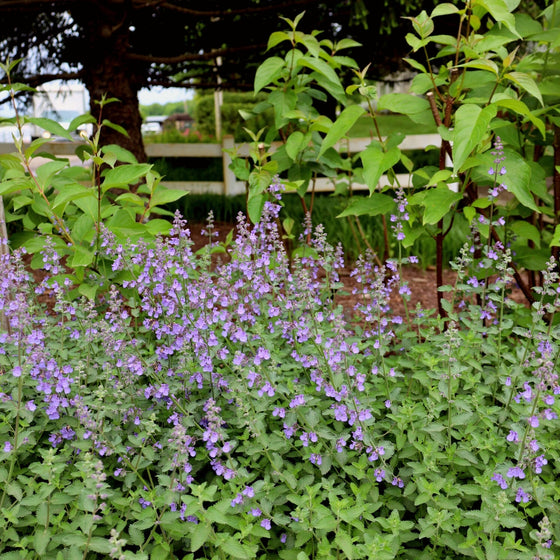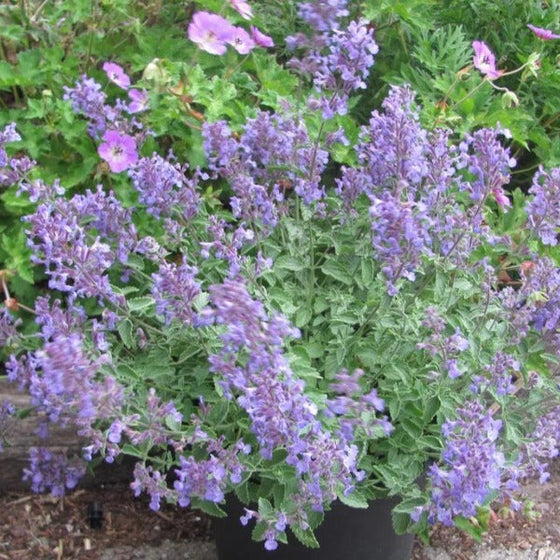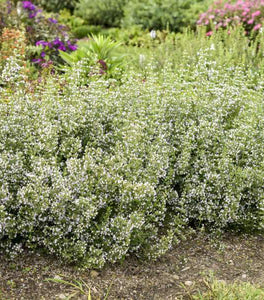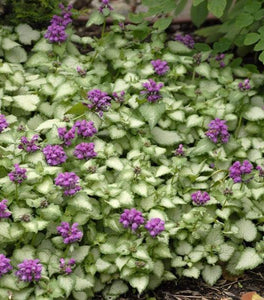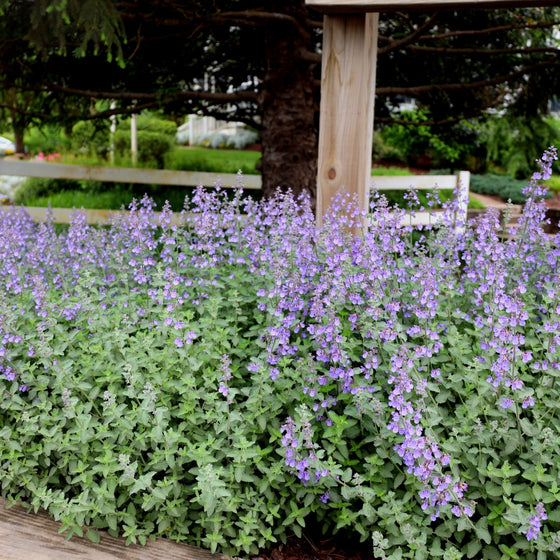
Images Depict Mature Plants
Junior Walker Catmint for Sale Online
Nepeta 'Junior Walker' is a compact, low-maintenance catmint variety prized for its soft, silvery-green foliage and abundant spikes of lavender-blue flowers that bloom from late spring through summer. A naturally dwarf form of the popular Nepeta 'Walker's Low', this cultivar stays neat and tidy at just 12 to 18 inches tall, making it perfect for edging borders, walkways, and containers. Its aromatic foliage is deer- and rabbit-resistant, while its profuse blooms attract bees, butterflies, and hummingbirds, making it a pollinator-friendly addition to any sunny garden.
This drought-tolerant perennial thrives in full sun and well-drained soil, and it performs exceptionally well in hot, dry conditions once established. Junior Walker catmint is ideal for xeriscaping, rock gardens, and mass plantings where it can spill gracefully over walls or soften hardscapes. The soft gray-green foliage forms a dense mound that serves as a beautiful backdrop for its vibrant flower spikes, offering long-lasting color and texture in the landscape. Deadheading spent blooms can encourage reblooming, though this plant remains attractive even as the flowers fade.
Hardy in USDA Zones 5–9, Nepeta 'Junior Walker' is a versatile performer that provides easy-care beauty with minimal upkeep. Its compact size and extended bloom time make it a popular choice for mixed borders, cottage gardens, and curbside plantings. Whether used as a colorful groundcover or in a pollinator-focused planting design, ‘Junior Walker’ catmint delivers fragrance, form, and long-season color in a durable, landscape-friendly package.
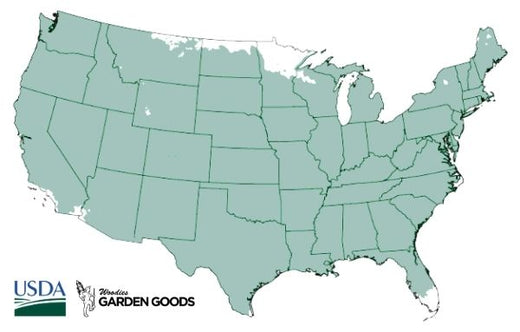
| Hardiness Zone: | 4-9 |
|---|---|
| Mature Height: | 1.5 to 2 Feet |
| Mature Width: | 1 to 2.5 Feet |
| Classification: | Perennial |
| Sunlight: | Full sun, partial sun |
| Habit: | Spreading, clump forming |
| Flower Color: | Lavender-Blue |
| Flowering Season: | Late May through September |
| Foliage: | Gray-green fragrant foliage |
| Soil Condition: | Prefers dry, average to sandy soil |
| Water Requirements: | Water well until established |
| Uses: | Extremely attractive when used as a focal point in the mixed border, mass planting; attracts pollinators |
How to Care for Junior Walker Catmint
Before you buy a Junior Walker Catmint Plant, be sure to read the recommended care instructions to keep this plant healthy and thriving for years to come!
How do I Plant Junior Walker Catmint?
To plant Junior Walker Catmint (Nepeta x faassenii 'Junior Walker'), choose a location that receives full sun for at least 6 hours a day and offers well-drained soil. This compact, drought-tolerant perennial thrives in poor to average soil conditions and is perfect for dry, sunny borders, rock gardens, or as an edging plant along walkways. Start by digging a hole twice as wide and just as deep as the plant’s root ball. Gently loosen the roots before placing the plant into the hole, then backfill with native soil and press firmly to eliminate air pockets. Water thoroughly after planting to help establish strong roots. Space Junior Walker Catmint plants about 18 to 24 inches apart to allow room for their low, spreading habit to fill in and create a soft, fragrant carpet of silvery-green foliage and lavender-blue blooms. Adding a layer of mulch around the base helps retain moisture and suppress weeds, but be sure to keep it a few inches away from the crown to prevent rot. This deer- and rabbit-resistant plant establishes quickly and needs minimal care once rooted, making it a perfect choice for pollinator gardens, Mediterranean-style landscapes, and low-maintenance garden designs.
How do I water Junior Walker Catmint?
Watering Junior Walker Catmint (Nepeta x faassenii 'Junior Walker') correctly is key to helping this drought-tolerant perennial thrive in the garden. During the first growing season, water the plant regularly—about once or twice a week—to keep the soil evenly moist while roots become established. Make sure the planting site has good drainage, as catmint dislikes soggy soil and can suffer from root rot if overwatered. Once established, Junior Walker Catmint requires much less frequent watering, making it an excellent choice for xeriscaping and low-water landscapes. In most climates, mature Junior Walker Catmint will only need supplemental water during extended dry periods or extreme summer heat. Always check the soil before watering—if the top 2 inches feel dry, it’s time to water deeply at the base of the plant. Avoid overhead watering to reduce the risk of mildew and keep the foliage looking clean and vibrant. With proper watering, this resilient and fragrant perennial will reward you with masses of lavender-blue flowers and aromatic, silvery foliage that attracts bees and butterflies while standing up to drought, heat, and browsing deer.
How do I fertilize Nepeta Junior Walker?
Fertilizing Junior Walker Catmint (Nepeta x faassenii 'Junior Walker') is simple and low-maintenance, as this hardy perennial thrives in lean to average soils. In early spring, apply a light dose of a balanced, slow-release fertilizer—such as a 10-10-10 formula—to encourage healthy foliage and prolific flowering. Scatter the fertilizer around the base of the plant, avoiding direct contact with the stems, and water thoroughly to help the nutrients absorb into the soil. Over-fertilizing should be avoided, as it can lead to excessive leafy growth at the expense of blooms and reduce the compact, mounding habit that makes this variety so desirable. For gardeners who prefer an organic approach, amending the soil with compost or well-aged manure in early spring is typically all that’s needed to keep Junior Walker Catmint growing strong throughout the season. In most cases, additional fertilization isn't necessary unless the plant shows signs of nutrient deficiency. Because this plant is naturally adapted to dry, low-nutrient environments, minimal feeding helps it maintain its durability, fragrance, and resistance to deer and drought. With the right balance of sunlight, well-drained soil, and a touch of spring feeding, Junior Walker Catmint will produce a long-lasting display of lavender-blue blooms and aromatic silver foliage.

How and when should I Prune Junior Walker Catmint plants?
Pruning Junior Walker Catmint (Nepeta x faassenii 'Junior Walker') is essential for maintaining its tidy, compact shape and encouraging a second flush of blooms. The best time for a major prune is just after the first bloom cycle in mid to late summer. Use clean, sharp shears to cut back the spent flower spikes and trim the plant by up to one-third of its height. This not only rejuvenates the foliage and encourages fresh growth, but also stimulates additional blooming into the late summer and early fall. Prompt pruning prevents the plant from becoming leggy and keeps the silvery-green mound looking neat and uniform. In early spring, prune back any winter-damaged or woody stems to make room for new growth. A light trim at this time also helps shape the plant before the growing season begins. Throughout the season, you can deadhead spent flowers as needed to prolong blooming and maintain a clean appearance. With proper pruning, Junior Walker Catmint remains one of the most attractive, low-maintenance, and pollinator-friendly perennials in sunny borders, cottage gardens, and rock gardens. Regular trimming encourages bushier growth, prevents self-seeding, and ensures a lush, lavender-blue display all season long.

